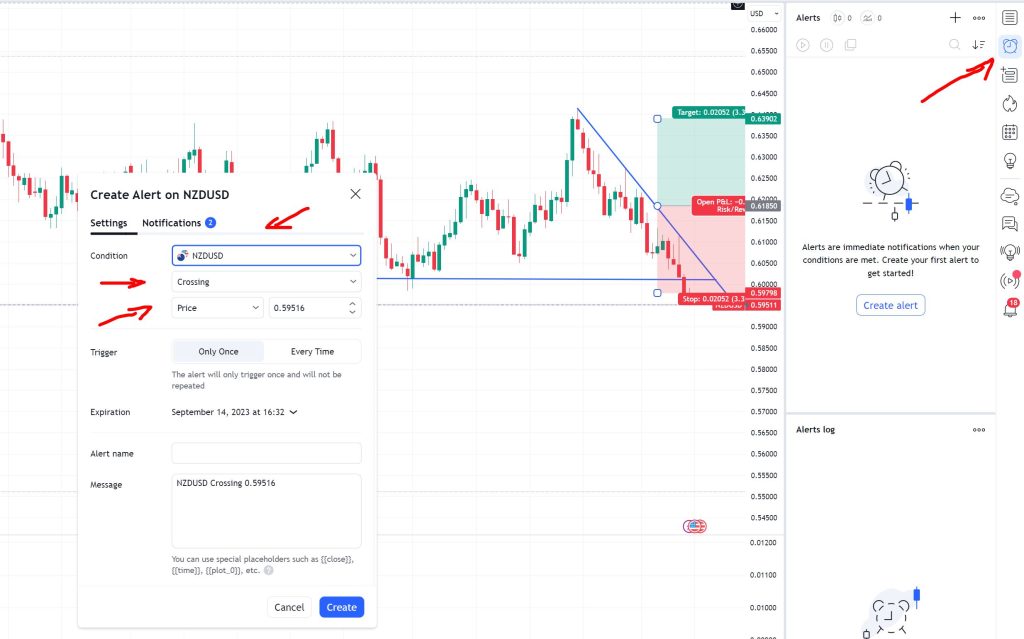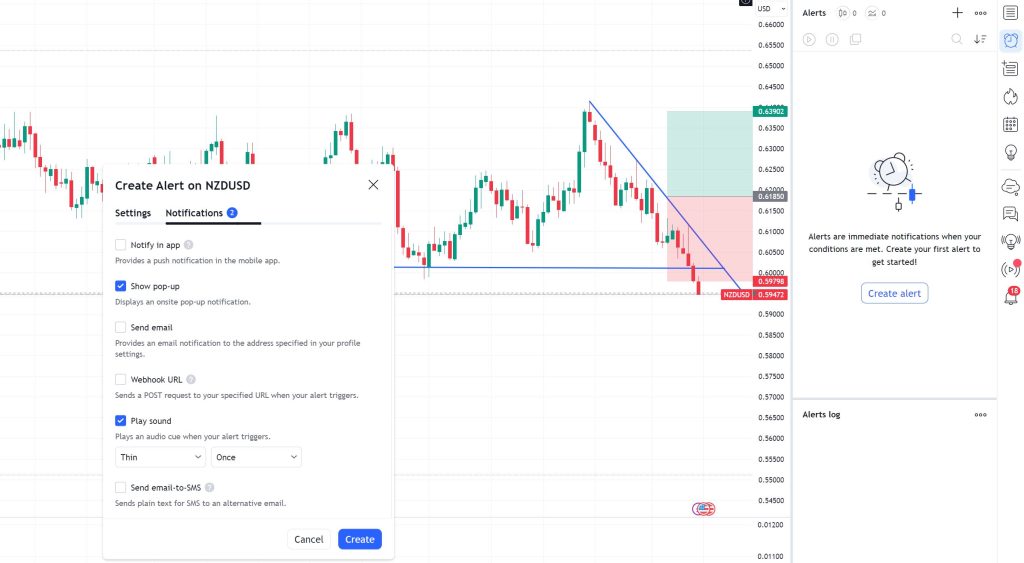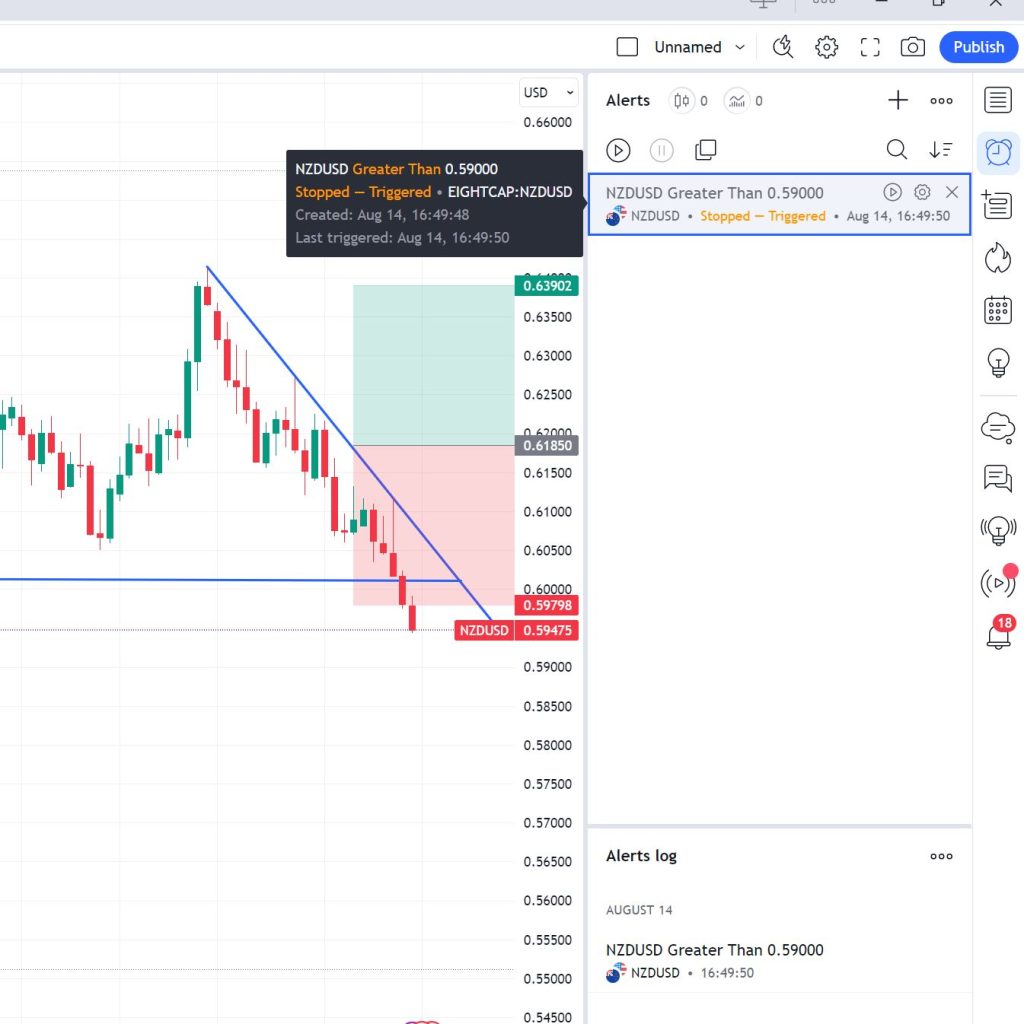Eightcap’s TradingView Account – Price Alerts

TradingView Price Alerts is a powerful tool that can help traders and investors stay on top of the market and make informed trading decisions. With Price Alerts, you can set up notifications to be alerted when the price of a particular market reaches a certain level, or when an indicator or strategy triggers a signal. This can help you to identify potential trading opportunities and to take action quickly when the market moves in your favor.
Here are some of the key features of TradingView Price Alerts:
Flexible Trigger Conditions: TradingView Price Alerts can be triggered by a variety of conditions, including:
- Price levels: You can set up an alert to be triggered when the price of a particular market reaches a certain level. For example, you could set up an alert to be triggered when the price of Apple stock reaches $150.
- Indicator values: You can set up an alert to be triggered when the value of an indicator reaches a certain level. For example, you could set up an alert to be triggered when the RSI indicator for a particular market reaches 70.
- Drawing tools: You can set up an alert to be triggered when the price of a particular market touches a certain drawing tool, such as a trendline or Fibonacci retracement level. This gives you the flexibility to create alerts that are tailored to your specific trading strategy. For example, if you are a day trader, you might want to set up alerts for key price levels that you are watching. If you are a swing trader, you might want to set up alerts for indicator values that signal a change in trend.

1. Multiple Notification Methods: TradingView Price Alerts can be notified via a variety of methods, including:
- Email: You will receive an email notification when your alert is triggered.
- Mobile push notifications: You will receive a notification on your mobile device when your alert is triggered.
- Desktop notifications: You will receive a notification on your computer when your alert is triggered. This ensures that you will never miss an important alert, no matter where you are or what you are doing. For example, if you are away from your computer, you will still be able to be notified of your alerts on your mobile device.

2. Advanced Alert Settings: TradingView Price Alerts can be customized with a variety of settings, including:
- Alert duration: You can specify how long your alert will be active. For example, you could set an alert to be active for 1 hour, 1 day, or 1 week.
- Frequency of notifications: You can specify how often you want to be notified of your alert. For example, you could set your alert to notify you once, or every 5 minutes.
- Alert message: You can specify the message that you want to receive when your alert is triggered. For example, you could set your alert to send you a message that says “Apple stock has reached $150.” This allows you to fine-tune your alerts to your specific needs. For example, if you are only interested in being notified of major price movements, you could set your alert duration to be short and your frequency of notifications to be low.
To set up a Price Alert on TradingView, simply follow these steps:
- Go to the chart of the security that you want to track.
- Click on the “Alerts” button in the top right corner of the chart.
- In the “Create Alert” dialog box, enter the trigger condition for your alert – in this case “Price”.
- Select the Condition – in this case “Crossing“
- Select if the Alert should trigger once or each time the price is crossed
- Select when this alert should expire
- Name your Alert – in this case “Apple Stock Higher Price alert“
- Select the notification methods that you want to use, from the Notifications tab.
- Click on the “CREATE” button.
Your Price Alert will now be activated. You will be notified when the trigger condition is met, according to the notification methods that you selected.
Here are some additional tips for using TradingView Price Alerts:
- Use Price Alerts to identify potential trading opportunities. By setting up Price Alerts for key price levels, you can identify potential trading opportunities before they happen. This can give you a significant edge over other traders.
- Use Price Alerts to manage your risk. Price Alerts can also be used to manage your risk by setting up alerts for stop-loss and profit-taking levels. This can help you to avoid losses and to maximize your profits.
- Use Price Alerts to stay on top of the market. Even if you can’t be watching the market all the time, Price Alerts can keep you informed of important price movements. This can help you to react quickly to market changes and to make informed trading decisions.
How to manage price alerts:
- Log in to your Eightcap TradingView Account ID.
- Go to the “Price Alerts” or “Watchlist” section.
- You will see a list of all the price alerts that you have set up.
- To edit an alert, click on the “Edit” button.
- To delete an alert, click on the “Delete” button.
- To create a new alert, click on the “Add Alert” button.
When you are creating a new alert, you will need to specify the following information:
- The symbol of the stock or security that you want to track.
- The price that you want to be alerted about.
- Whether you want to be alerted when the price crosses above or below the specified price.
- The notification method that you want to use (email, SMS text message, or push notification).

Once you have created an alert, you will be able to view it in the “Price Alerts” or “Watchlist” section. You can also edit or delete the alert at any time.
Here are some additional tips for managing price alerts:
- Only set up alerts for stocks or securities that you are interested in buying or selling.
- Set realistic price targets for your alerts. If you set the price too high, you may never be alerted.
- Review your alerts regularly and make sure that they are still relevant.
Price alerts can be a helpful tool for investors who want to stay up-to-date on the market and make informed trading decisions. However, it is important to use price alerts wisely and to set realistic expectations. Price alerts are not a guarantee of profitability, and they should not be used as the sole basis for making investment decisions. Traders and Investors should always do their own research or consult with a financial advisor before making any investment decisions.
* The information provided here has been prepared by Eightcap’s team of analysts. All expressions of opinion are subject to change without notice. Any opinions made may be personal to the author and do not reflect the opinions of Eightcap.
In addition to the disclaimer on our website, the material on this page does not contain a record of our trading prices, or represent an offer or solicitation for a transaction in any financial instrument. Eightcap accepts no responsibility for any use that may be made of these comments and for any consequences that result. No representation or warranty is given as to the accuracy or completeness of this information. Consequently, any person acting on it does so entirely at their own risk. Any research provided does not have regard to the specific investment objectives, financial situation and needs of any specific person who may receive it. It has not been prepared in accordance with legal requirements designed to promote the independence of investment research and as such is considered to be a marketing communication.
Please note that past performance is not a guarantee or prediction of future performance. This communication must not be reproduced or further distributed without prior permission.


